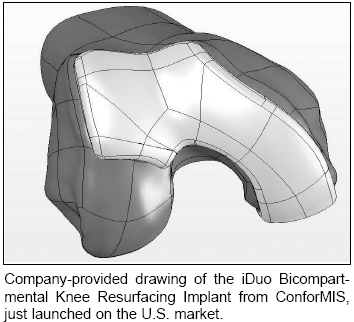Medical Device Daily Executive Editor
ConforMIS (Burlington, Massachusetts) is knee-deep in development of solutions aimed at less-invasive approaches to resolving the painful condition known as osteoarthritis.
Its latest commercialized product, just launched in the U.S. after receipt of 510(k) approval by the FDA back in March 2006, is the iDuo, which the innovative company terms "the first patient-specific bicompartmental knee resurfacing implant on the market."

The iDuo is designed for patients whose arthritic damage is limited to either the medial or lateral compartment of the knee, in addition to the patellofemoral compartment. ConforMIS says that 30% to 50% of patients who receive a total knee replacement (TKR) exhibit symptoms of osteoarthritis in just one or two of the three compartments of the knee.
Aimed at that market, the iDuo resurfaces only the affected areas, thus, according to the company, "preserving far more bone on both the femur and tibia than traditional knee replacement surgery."
The iDuo also preserves both the anterior and posterior cruciate ligaments, helping to maintain natural knee kinematics. The company said the extent of tissue preservation made possible with the iDuo "helps patients retain their future surgical options."
Each iDuo is designed from an individual patient's CT scan using the company's proprietary iFit technology and made specifically for that patient. The iDuo allows for individualized fit, including full coverage of the tibial cortical rim, and a simplified surgical technique.
"The move toward patient-specific approaches opens up possibilities for patients who were never ideal candidates for a total knee replacement," said Tom Minas, MD, director of the Cartilage Repair Center at Brigham and Women's Hospital (Boston). He was part of the surgeon design team for the iDuo.
"As a surgeon," Minas said, "what has been especially intriguing for me is how much this approach has simplified and improved the surgical technique that can be employed for partial knee procedures."
Philipp Lang, MD, chairman/CEO of ConforMIS, said, "The iDuo significantly advances the range of treatment options for patients who suffer from knee osteoarthritis." Whereas a patient with bicompartmental disease traditionally has had TKR as the only option, he said that the iDuo "provides a less-invasive alternative for young and active patients that maintains their ability to move to a total knee in the future, if necessary."
Lang told Medical Device Daily, "The fundamental challenge is that while you're trying to be bone-preserving, if you're doing any bone-cutting, you're limited in the amount of bone preservation you can achieve."
He said that the iDuo surgical technique is "highly reproducible ... a fundamentally different approach to partial knee replacement. It will challenge the surgeon as to how they deal with knees, addressing the primary failure problems."
Lang added that ConforMIS has "basically married our system with a very reproducible technique. It wasn't even how we started out, but that's where development has taken us."
Jong Lee, senior VP of marketing for the company, said when asked by MDD about surgeon response to the new system, "The doctors are pretty positive. For them, this is very novel. For the majority of docs to whom we're talking, the whole notion of bicompartmental implants is novel to them."
He added: "It looks innovative, it looks new, and it addresses one of the things that they worry about with unicompartmental, which is progression of disease to the patellar tendon region. So we have docs look at the iDuo and say, that's really interesting, that's something I'd like to know more about."
Noting that a number of surgeons are incorporating use of the iDuo system into their practices, Lee added: "The place where there has been the most wow' effect has been in the surgical technique and the way in which we do it with our jig system."
The iDuo comes packaged together with patient-specific instrumentation called iJigs, designed from the same scans as the implant, including data on the patient's biomechanical axis. ConforMIS says the iJig cutting and placement guides eliminate manual sizing during surgery and provide tactile guidance to precisely place the instruments, simplifying the surgical technique.
One tray of disposable iJigs replaces multiple trays of traditional instrumentation that would typically have cost a hospital several hundred dollars per surgery in instrument handling, storage, sterilization and lost operating room time.
Lee cited the ongoing enhancements to the product, noting, "We don't have millions and millions of dollars of inventory out in the field that prevents us from making good, meaningful changes if they're important. If we get feedback that says, this is a much better way to do something, we have the ability to move on that pretty quickly, try it out in lab or skill sessions, then get it out into the field."
Lang noted the conservative approach the company has taken to release of the product, saying that it initially was placed only with surgeon advisors, then in limited release with a select number of surgeons.
Lee said the ConforMIS approach is that of offering a "personalized medicine option, or patient-specific option."
He added, "When you start thinking in a patient-specific way, it changes the ways that you can approach the problem. There is a whole range of things like bone preservation, simplicity of surgical technique, ability to provide full cortical rim coverage, that are only possible because we're using patient-specific data as the starting point."
Lee said, "That's what we think about a lot – how do we use personalization to get a better clinical result?"

